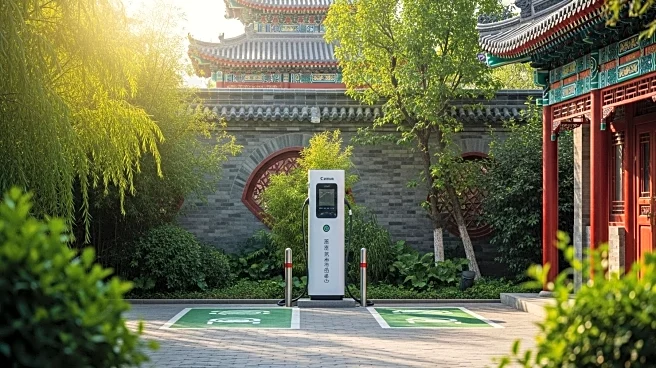What is the story about?
What's Happening?
A research team at the University of Sydney has developed a new triple-junction tandem perovskite solar cell, setting a world record for conversion efficiency and stability. The cell architecture consists of two layers of perovskite combined with silicon, achieving a conversion efficiency of 23.3% for a 16 square centimeter cell and 27.06% for a smaller 1 square centimeter cell. This advancement addresses the durability issues associated with perovskite materials, which are known for their efficiency but lack stability. The research, published in Nature Nanotechnology, highlights the potential for scaling up these cells for commercial use, with the smaller cell passing rigorous thermal stability tests. The collaborative effort involved partners from China, Germany, and Slovenia, showcasing international cooperation in solar technology innovation.
Why It's Important?
The development of this advanced perovskite solar cell is significant for the global solar industry, as it promises cheaper and more sustainable solar energy solutions. The high efficiency and improved stability of these cells could lead to widespread adoption, reducing reliance on silicon-based solar cells, which are more expensive. This innovation aligns with global efforts to transition to low-carbon energy sources, potentially impacting energy policies and market dynamics. The U.S., despite its historical leadership in perovskite research, may face increased competition from international players, influencing domestic energy strategies and investments.
What's Next?
The next steps involve scaling up the production of these solar cells for commercial deployment. Researchers will focus on maintaining efficiency and durability at larger scales, which is crucial for practical applications. The success of this technology could prompt increased investment in perovskite research and development, potentially leading to new partnerships and collaborations across the solar industry. Stakeholders, including governments and energy companies, may need to adapt their strategies to incorporate these advancements into their renewable energy portfolios.
Beyond the Headlines
The use of gold nanoparticles in the cell's architecture highlights the innovative approaches being taken to enhance solar technology. This could lead to further exploration of nanotechnology applications in energy solutions. Additionally, the international collaboration underscores the importance of cross-border partnerships in advancing scientific research, which may influence future policy decisions regarding global energy cooperation.
AI Generated Content
Do you find this article useful?















